warning TOYOTA C-HR 2020 Warranties & Maintenance Guides (in English)
[x] Cancel search | Manufacturer: TOYOTA, Model Year: 2020, Model line: C-HR, Model: TOYOTA C-HR 2020Pages: 260, PDF Size: 8.54 MB
Page 46 of 260
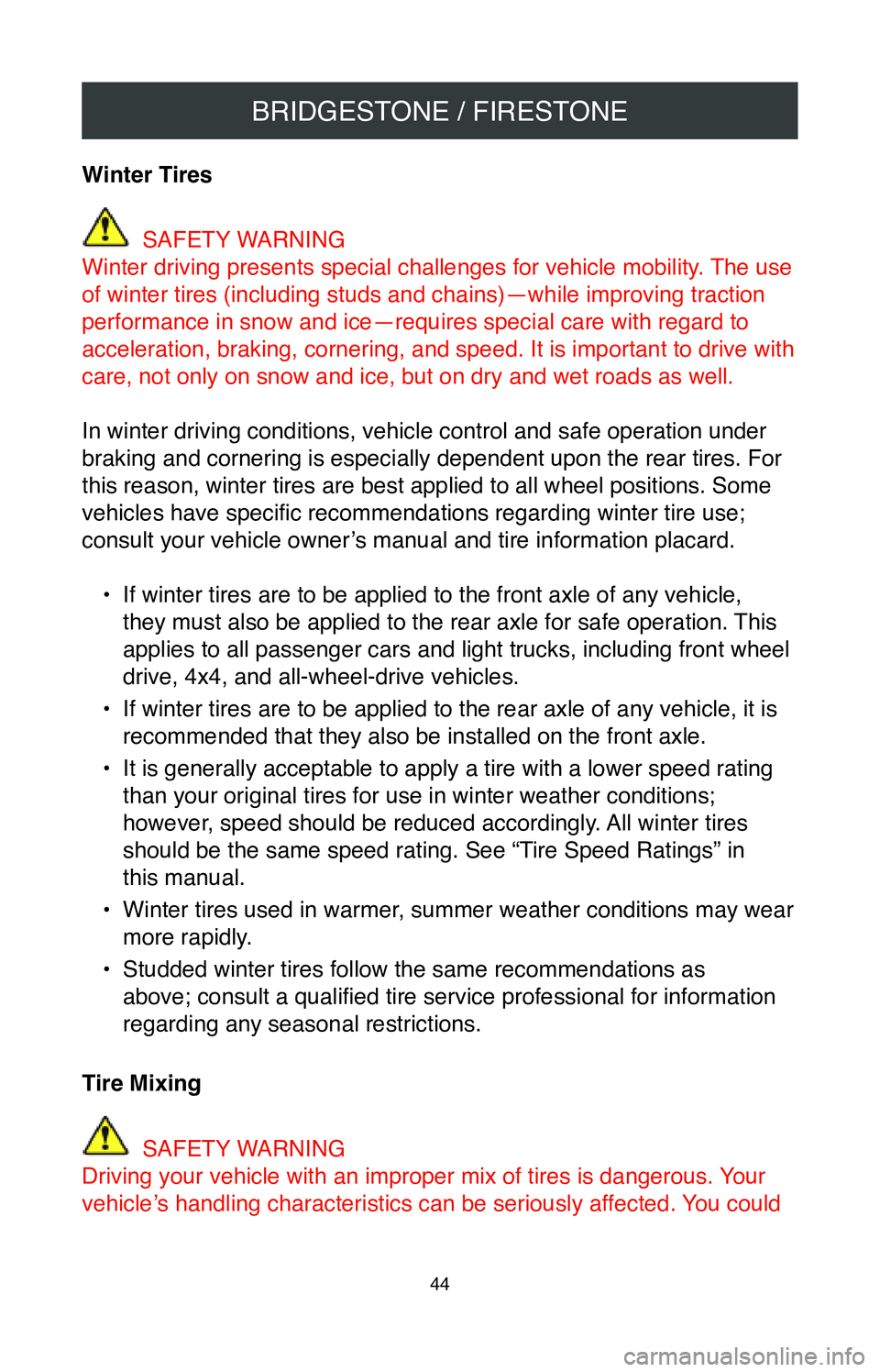
BRIDGESTONE / FIRESTONE
44
Winter Tires
SAFETY WARNING
Winter driving presents special challenges for vehicle mobility. The use
of winter tires (including studs and chains)—while improving traction
performance in snow and ice—requires special care with regard to
acceleration, braking, cornering, and speed. It is important to drive wi\
th
care, not only on snow and ice, but on dry and wet roads as well.
In winter driving conditions, vehicle control and safe operation under
braking and cornering is especially dependent upon the rear tires. For
this reason, winter tires are best applied to all wheel positions. Some \
vehicles have specific recommendations regarding winter tire use;
consult your vehicle owner’s manual and tire information placard.
•
If winter tires are to be applied to the front axle of any vehicle,
they must also be applied to the rear axle for safe operation. This
applies to all passenger cars and light trucks, including front wheel
drive, 4x4, and all-wheel-drive vehicles.
•
If winter tires are to be applied to the rear axle of any vehicle, it is\
recommended that they also be installed on the front axle.
•
It is generally acceptable to apply a tire with a lower speed rating
than your original tires for use in winter weather conditions;
however, speed should be reduced accordingly. All winter tires
should be the same speed rating. See “Tire Speed Ratings” in
this manual.
•
Winter tires used in warmer, summer weather conditions may wear
more rapidly.
•
Studded winter tires follow the same recommendations as
above; consult a qualified tire service professional for information
regarding any seasonal restrictions.
Tire Mixing
SAFETY WARNING
Driving your vehicle with an improper mix of tires is dangerous. Your
vehicle’s handling characteristics can be seriously affected. You could
Page 47 of 260
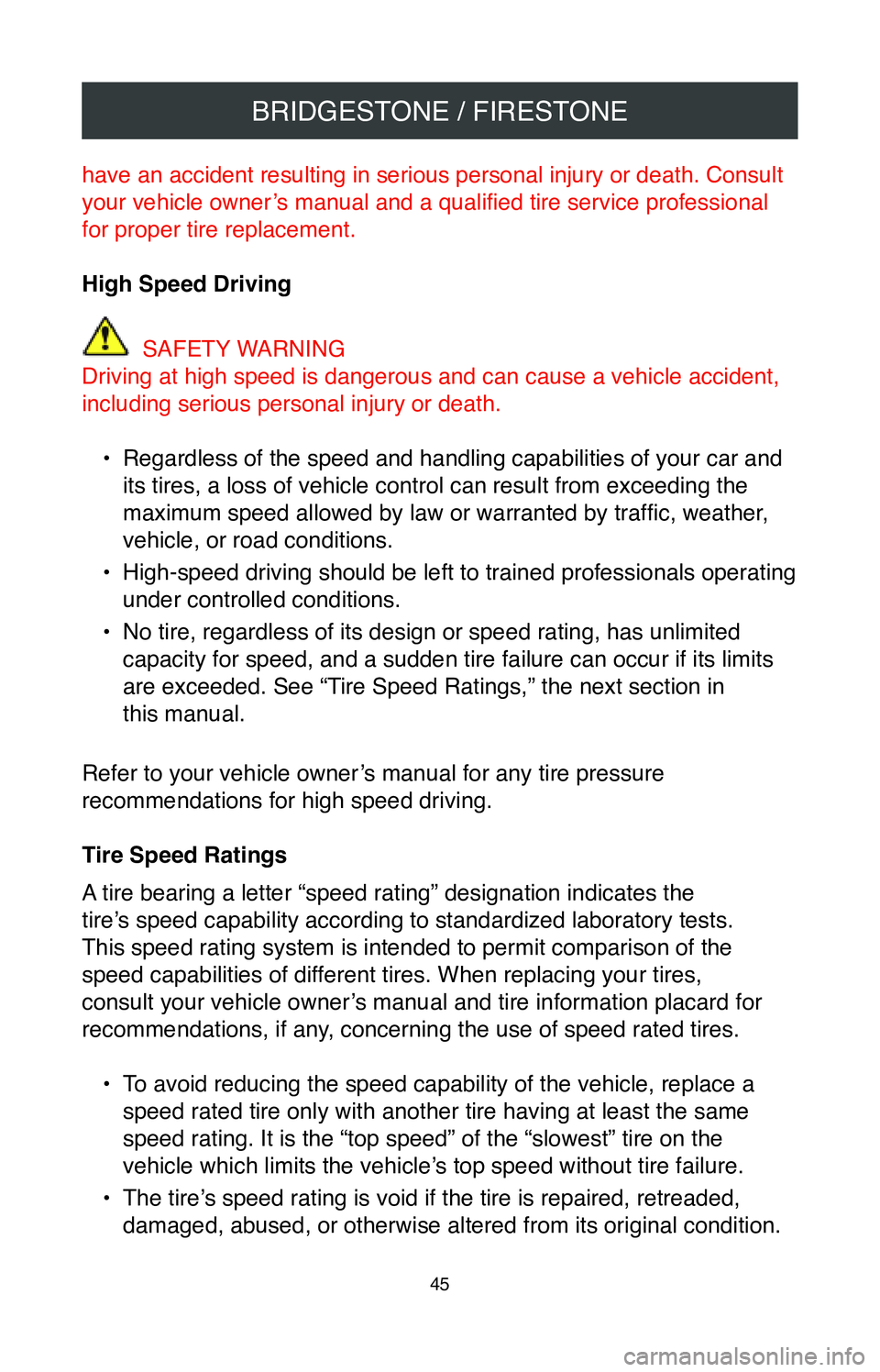
BRIDGESTONE / FIRESTONE
45
have an accident resulting in serious personal injury or death. Consult
your vehicle owner’s manual and a qualified tire service professional
for proper tire replacement.
High Speed Driving
SAFETY WARNING
Driving at high speed is dangerous and can cause a vehicle accident,
including serious personal injury or death.
•
Regardless of the speed and handling capabilities of your car and
its tires, a loss of vehicle control can result from exceeding the
maximum speed allowed by law or warranted by traffic, weather,
vehicle, or road conditions.
•
High-speed driving should be left to trained professionals operating
under controlled conditions.
•
No tire, regardless of its design or speed rating, has unlimited
capacity for speed, and a sudden tire failure can occur if its limits
are exceeded. See “Tire Speed Ratings,” the next section in
this manual.
Refer to your vehicle owner’s manual for any tire pressure
recommendations for high speed driving.
Tire Speed Ratings
A tire bearing a letter “speed rating” designation indicates the
tire’s speed capability according to standardized laboratory tests.
This speed rating system is intended to permit comparison of the
speed capabilities of different tires. When replacing your tires,
consult your vehicle owner’s manual and tire information placard for
recommendations, if any, concerning the use of speed rated tires. •
To avoid reducing the speed capability of the vehicle, replace a
speed rated tire only with another tire having at least the same
speed rating. It is the “top speed” of the “slowest” tire on\
the
vehicle which limits the vehicle’s top speed without tire failure.
•
The tire’s speed rating is void if the tire is repaired, retreaded,
damaged, abused, or otherwise altered from its original condition.
Page 49 of 260
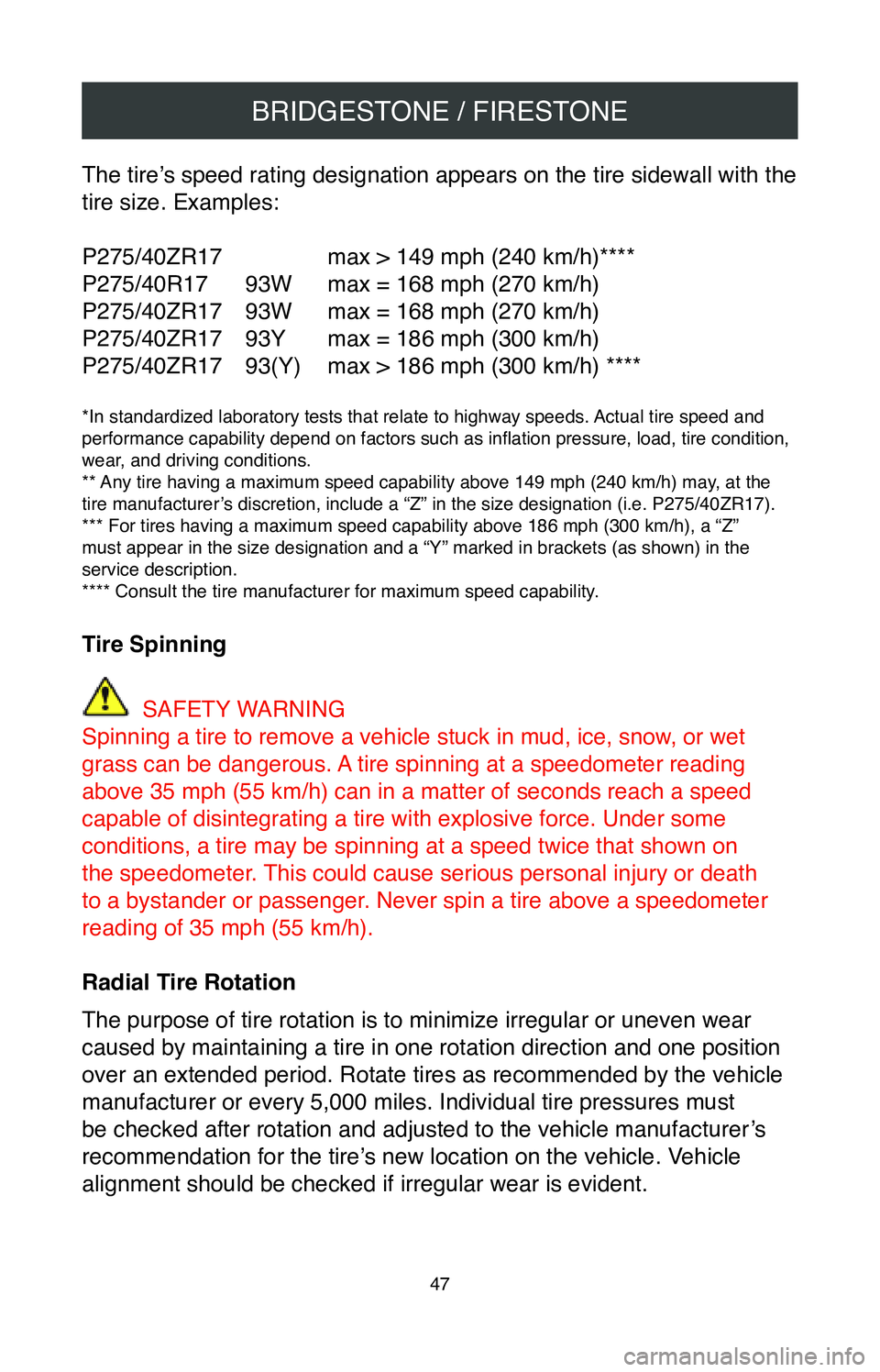
BRIDGESTONE / FIRESTONE
47
The tire’s speed rating designation appears on the tire sidewall with the
tire size. Examples:
P275/40ZR17
max > 149 mph (240 km/h)****
P275/40R17
93W max = 168 mph (270 km/h)
P275/40ZR17
93W max = 168 mph (270 km/h)
P275/40ZR17
93Y max = 186 mph (300 km/h)
P275/40ZR17
93(Y) max > 186 mph (300 km/h) ****
*In standardized laboratory tests that relate to highway speeds. Actual tire speed and
performance capability depend on factors such as inflation pressure, load, tire condition,
wear, and driving conditions.
** Any tire having a maximum speed capability above 149 mph (240 km/h) may, at the
tire manufacturer’s discretion, include a “Z” in the size designation (i.e. P275/40ZR17).
*** For tires having a maximum speed capability above 186 mph (300 km/h), a “Z”
must appear in the size designation and a “Y” marked in brackets (as shown) in the
service description.
**** Consult the tire manufacturer for maximum speed capability.
Tire Spinning
SAFETY WARNING
Spinning a tire to remove a vehicle stuck in mud, ice, snow, or wet
grass can be dangerous. A tire spinning at a speedometer reading
above 35 mph (55 km/h) can in a matter of seconds reach a speed
capable of disintegrating a tire with explosive force. Under some
conditions, a tire may be spinning at a speed twice that shown on
the speedometer. This could cause serious personal injury or death
to a bystander or passenger. Never spin a tire above a speedometer
reading of 35 mph (55 km/h).
Radial Tire Rotation
The purpose of tire rotation is to minimize irregular or uneven wear
caused by maintaining a tire in one rotation direction and one position \
over an extended period. Rotate tires as recommended by the vehicle
manufacturer or every 5,000 miles. Individual tire pressures must
be checked after rotation and adjusted to the vehicle manufacturer ’s
recommendation for the tire’s new location on the vehicle. Vehicle
alignment should be checked if irregular wear is evident.
Page 51 of 260
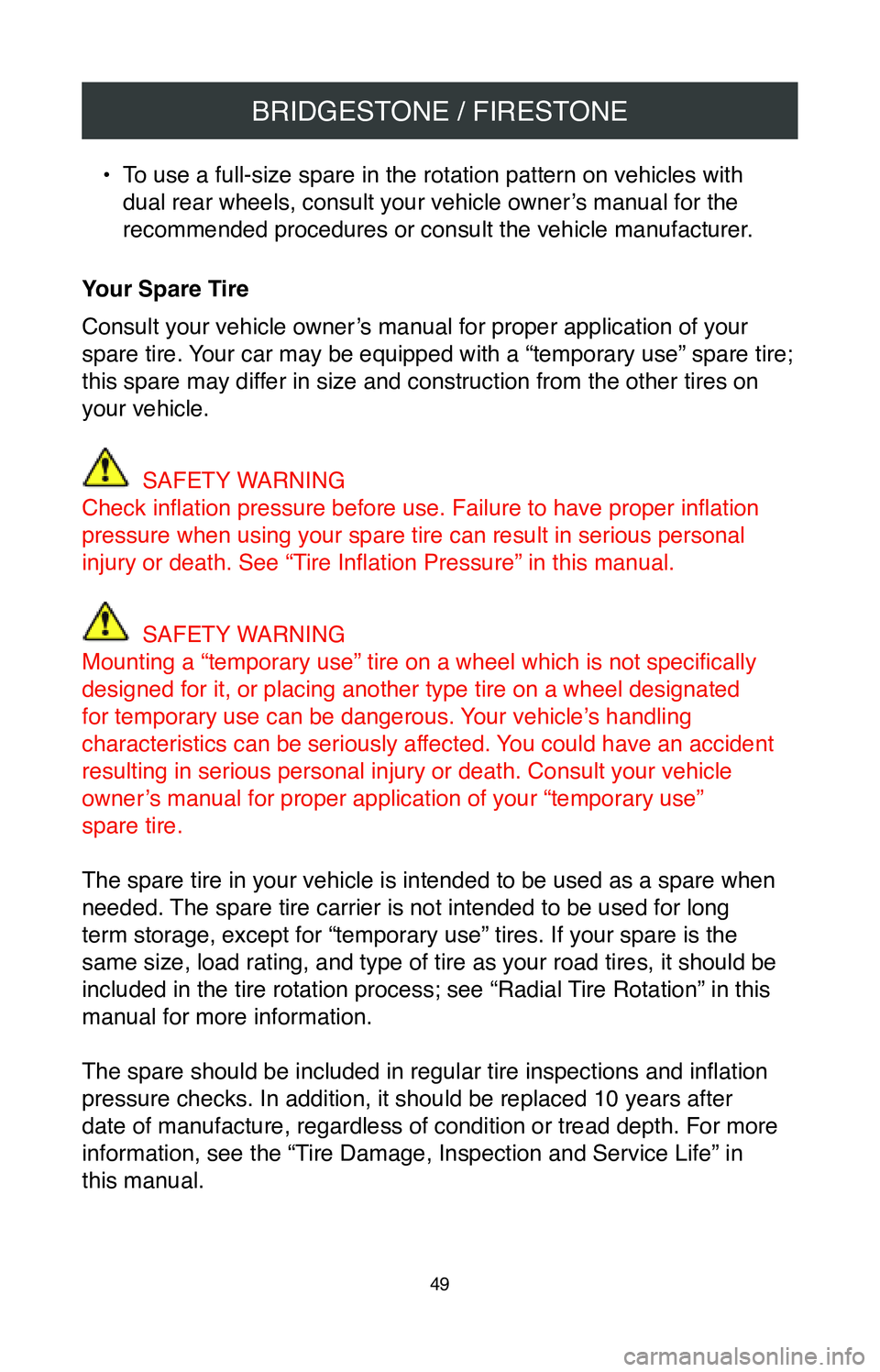
BRIDGESTONE / FIRESTONE
49
• To use a full-size spare in the rotation pattern on vehicles with
dual rear wheels, consult your vehicle owner’s manual for the
recommended procedures or consult the vehicle manufacturer.
Your Spare Tire
Consult your vehicle owner’s manual for proper application of your
spare tire. Your car may be equipped with a “temporary use” spare tire;
this spare may differ in size and construction from the other tires on
your vehicle.
SAFETY WARNING
Check inflation pressure before use. Failure to have proper inflation
pressure when using your spare tire can result in serious personal
injury or death. See “Tire Inflation Pressure” in this manual.
SAFETY WARNING
Mounting a “temporary use” tire on a wheel which is not specifically
designed for it, or placing another type tire on a wheel designated
for temporary use can be dangerous. Your vehicle’s handling
characteristics can be seriously affected. You could have an accident
resulting in serious personal injury or death. Consult your vehicle
owner’s manual for proper application of your “temporary use”
spare tire.
The spare tire in your vehicle is intended to be used as a spare when
needed. The spare tire carrier is not intended to be used for long
term storage, except for “temporary use” tires. If your spare is t\
he
same size, load rating, and type of tire as your road tires, it should b\
e
included in the tire rotation process; see “Radial Tire Rotation” in this
manual for more information.
The spare should be included in regular tire inspections and inflation
pressure checks. In addition, it should be replaced 10 years after
date of manufacture, regardless of condition or tread depth. For more
information, see the “Tire Damage, Inspection and Service Life” in
this manual.
Page 52 of 260
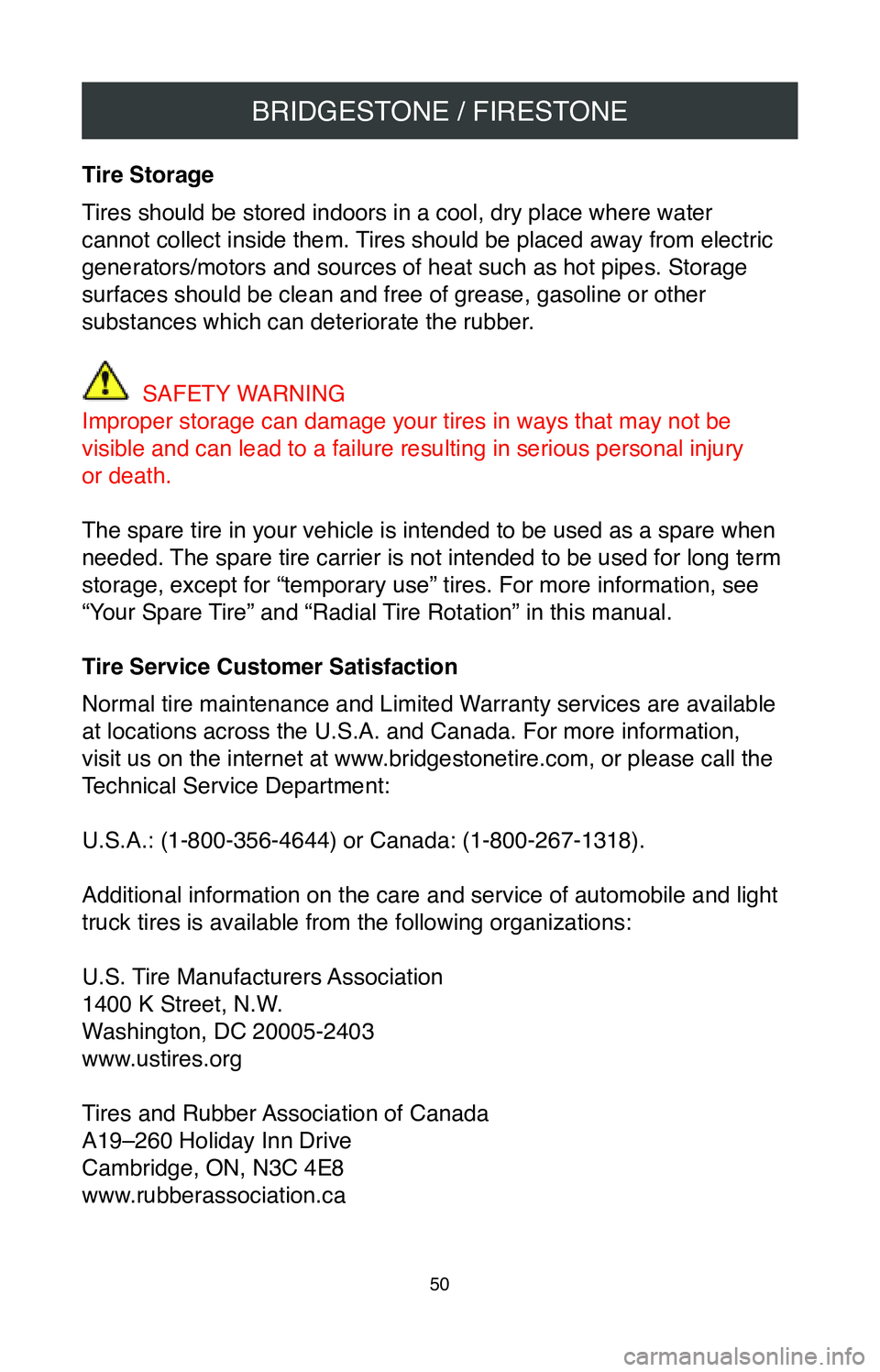
BRIDGESTONE / FIRESTONE
50
Tire Storage
Tires should be stored indoors in a cool, dry place where water
cannot collect inside them. Tires should be placed away from electric
generators/motors and sources of heat such as hot pipes. Storage
surfaces should be clean and free of grease, gasoline or other
substances which can deteriorate the rubber.
SAFETY WARNING
Improper storage can damage your tires in ways that may not be
visible and can lead to a failure resulting in serious personal injury
or death.
The spare tire in your vehicle is intended to be used as a spare when
needed. The spare tire carrier is not intended to be used for long term
storage, except for “temporary use” tires. For more information, s\
ee
“Your Spare Tire” and “Radial Tire Rotation” in this manual.
Tire Service Customer Satisfaction
Normal tire maintenance and Limited Warranty services are available
at locations across the U.S.A. and Canada. For more information,
visit us on the internet at www.bridgestonetire.com, or please call the
Technical Service Department:
U.S.A.: (1-800-356-4644) or Canada: (1-800-267-1318).
Additional information on the care and service of automobile and light
truck tires is available from the following organizations:
U.S. Tire Manufacturers Association
1400 K Street, N.W.
Washington, DC 20005-2403
www.ustires.org
Tires and Rubber Association of Canada
A19–260 Holiday Inn Drive
Cambridge, ON, N3C 4E8
www.rubberassociation.ca
Page 54 of 260
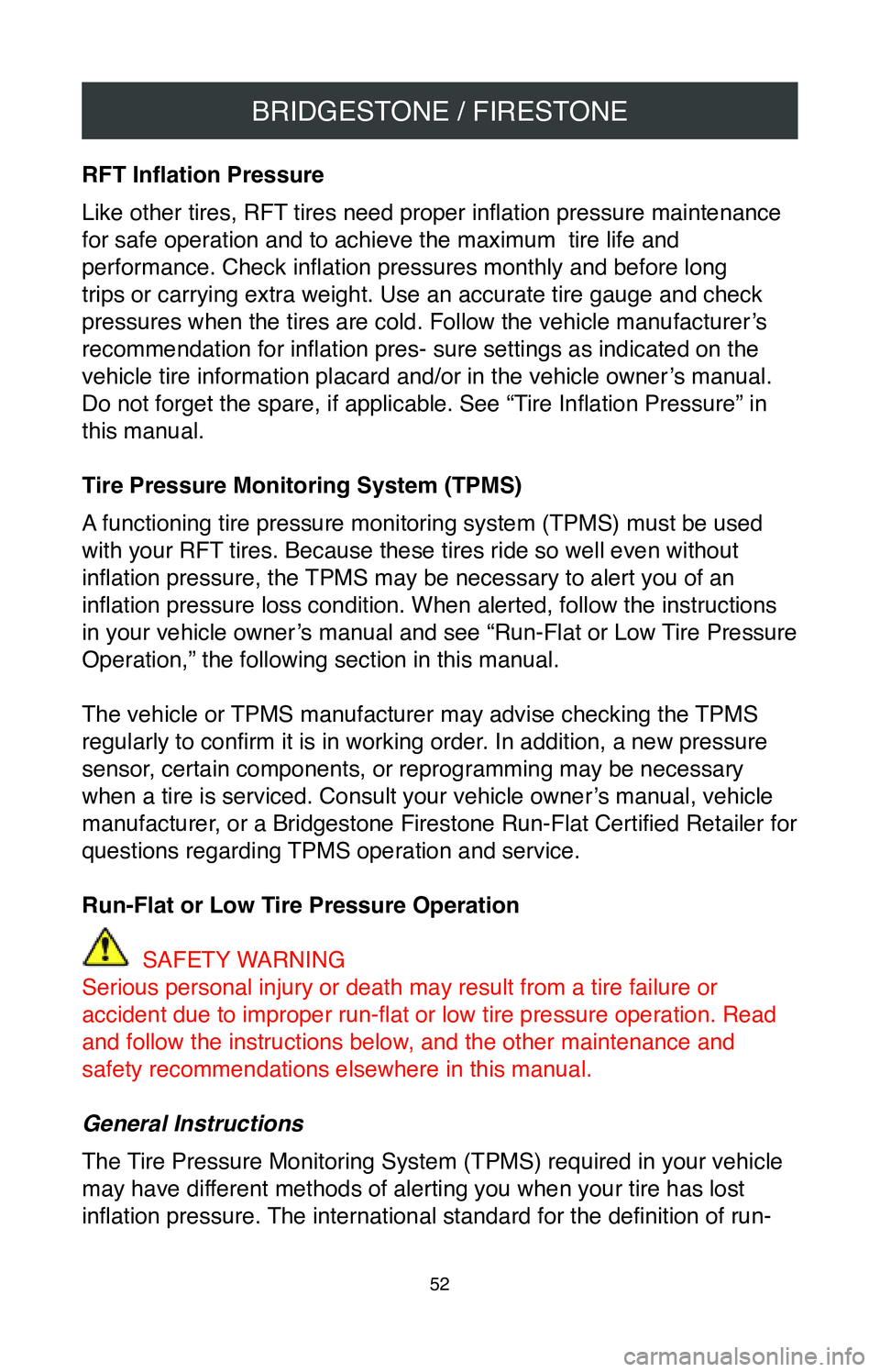
BRIDGESTONE / FIRESTONE
52
RFT Inflation Pressure
Like other tires, RFT tires need proper inflation pressure maintenance
for safe operation and to achieve the maximum tire life and
performance. Check inflation pressures monthly and before long
trips or carrying extra weight. Use an accurate tire gauge and check
pressures when the tires are cold. Follow the vehicle manufacturer’s
recommendation for inflation pres- sure settings as indicated on the
vehicle tire information placard and/or in the vehicle owner’s manual.
Do not forget the spare, if applicable. See “Tire Inflation Pressure” in
this manual.
Tire Pressure Monitoring System (TPMS)
A functioning tire pressure monitoring system (TPMS) must be used
with your RFT tires. Because these tires ride so well even without
inflation pressure, the TPMS may be necessary to alert you of an
inflation pressure loss condition. When alerted, follow the instructions
in your vehicle owner’s manual and see “Run-Flat or Low Tire Pressure
Operation,” the following section in this manual.
The vehicle or TPMS manufacturer may advise checking the TPMS
regularly to confirm it is in working order. In addition, a new pressure
sensor, certain components, or reprogramming may be necessary
when a tire is serviced. Consult your vehicle owner’s manual, vehicle
manufacturer, or a Bridgestone Firestone Run-Flat Certified Retailer for
questions regarding TPMS operation and service.
Run-Flat or Low Tire Pressure Operation
SAFETY WARNING
Serious personal injury or death may result from a tire failure or
accident due to improper run-flat or low tire pressure operation. Read
and follow the instructions below, and the other maintenance and
safety recommendations elsewhere in this manual.
General Instructions
The Tire Pressure Monitoring System (TPMS) required in your vehicle
may have different methods of alerting you when your tire has lost
inflation pressure. The international standard for the definition of run-
Page 61 of 260
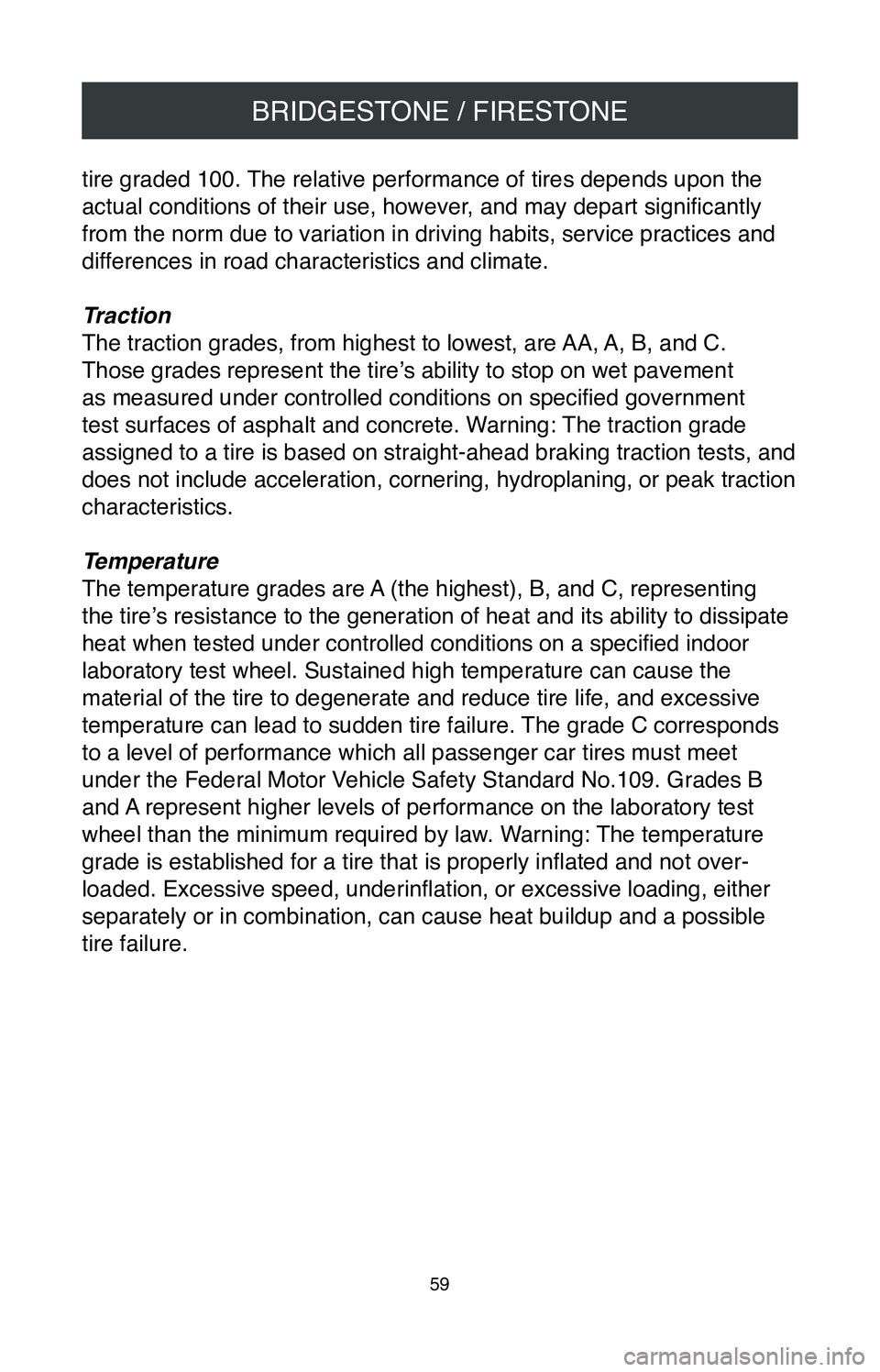
BRIDGESTONE / FIRESTONE
59
tire graded 100. The relative performance of tires depends upon the
actual conditions of their use, however, and may depart significantly
from the norm due to variation in driving habits, service practices and \
differences in road characteristics and climate.
Traction
The traction grades, from highest to lowest, are AA, A, B, and C.
Those grades represent the tire’s ability to stop on wet pavement
as measured under controlled conditions on specified government
test surfaces of asphalt and concrete. Warning: The traction grade
assigned to a tire is based on straight-ahead braking traction tests, and
does not include acceleration, cornering, hydroplaning, or peak traction\
characteristics.
Temperature
The temperature grades are A (the highest), B, and C, representing
the tire’s resistance to the generation of heat and its ability to dissipate
heat when tested under controlled conditions on a specified indoor
laboratory test wheel. Sustained high temperature can cause the
material of the tire to degenerate and reduce tire life, and excessive
temperature can lead to sudden tire failure. The grade C corresponds
to a level of performance which all passenger car tires must meet
under the Federal Motor Vehicle Safety Standard No.109. Grades B
and A represent higher levels of performance on the laboratory test
wheel than the minimum required by law. Warning: The temperature
grade is established for a tire that is properly inflated and not over-
loaded. Excessive speed, underinflation, or excessive loading, either
separately or in combination, can cause heat buildup and a possible
tire failure.
Page 63 of 260
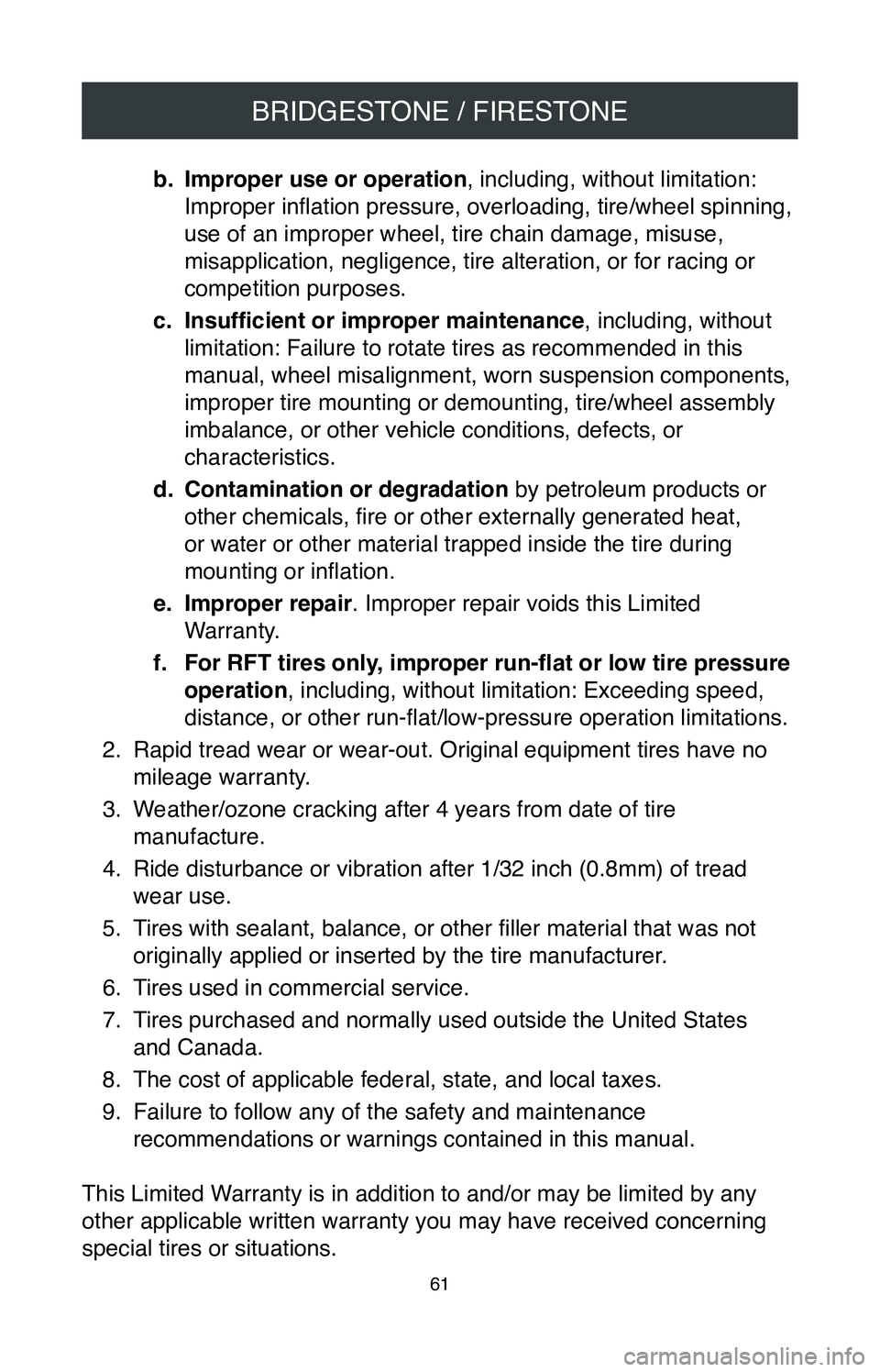
BRIDGESTONE / FIRESTONE
61
b. Improper use or operation, including, without limitation:
Improper inflation pressure, overloading, tire/wheel spinning,
use of an improper wheel, tire chain damage, misuse,
misapplication, negligence, tire alteration, or for racing or
competition purposes.
c.
Insufficient or improper maintenance , including, without
limitation: Failure to rotate tires as recommended in this
manual, wheel misalignment, worn suspension components,
improper tire mounting or demounting, tire/wheel assembly
imbalance, or other vehicle conditions, defects, or
characteristics.
d.
Contamination or degradation by petroleum products or
other chemicals, fire or other externally generated heat,
or water or other material trapped inside the tire during
mounting or inflation.
e.
Improper repair. Improper repair voids this Limited
Warranty.
f.
For RFT tires only, improper run-flat or low tire pressure
operation, including, without limitation: Exceeding speed,
distance, or other run-flat/low-pressure operation limitations.
2.
Rapid tread wear or wear-out. Original equipment tires have no
mileage warranty.
3.
Weather/ozone cracking after 4 years from date of tire
manufacture.
4.
Ride disturbance or vibration after 1/32 inch (0.8mm) of tread
wear use.
5.
Tires with sealant, balance, or other filler material that was not
originally applied or inserted by the tire manufacturer.
6.
Tires used in commercial service.
7.
Tires purchased and normally used outside the United States
and Canada.
8.
The cost of applicable federal, state, and local taxes.
9.
Failure to follow any of the safety and maintenance
recommendations or warnings contained in this manual.
This Limited Warranty is in addition to and/or may be limited by any
other applicable written warranty you may have received concerning
special tires or situations.
Page 71 of 260
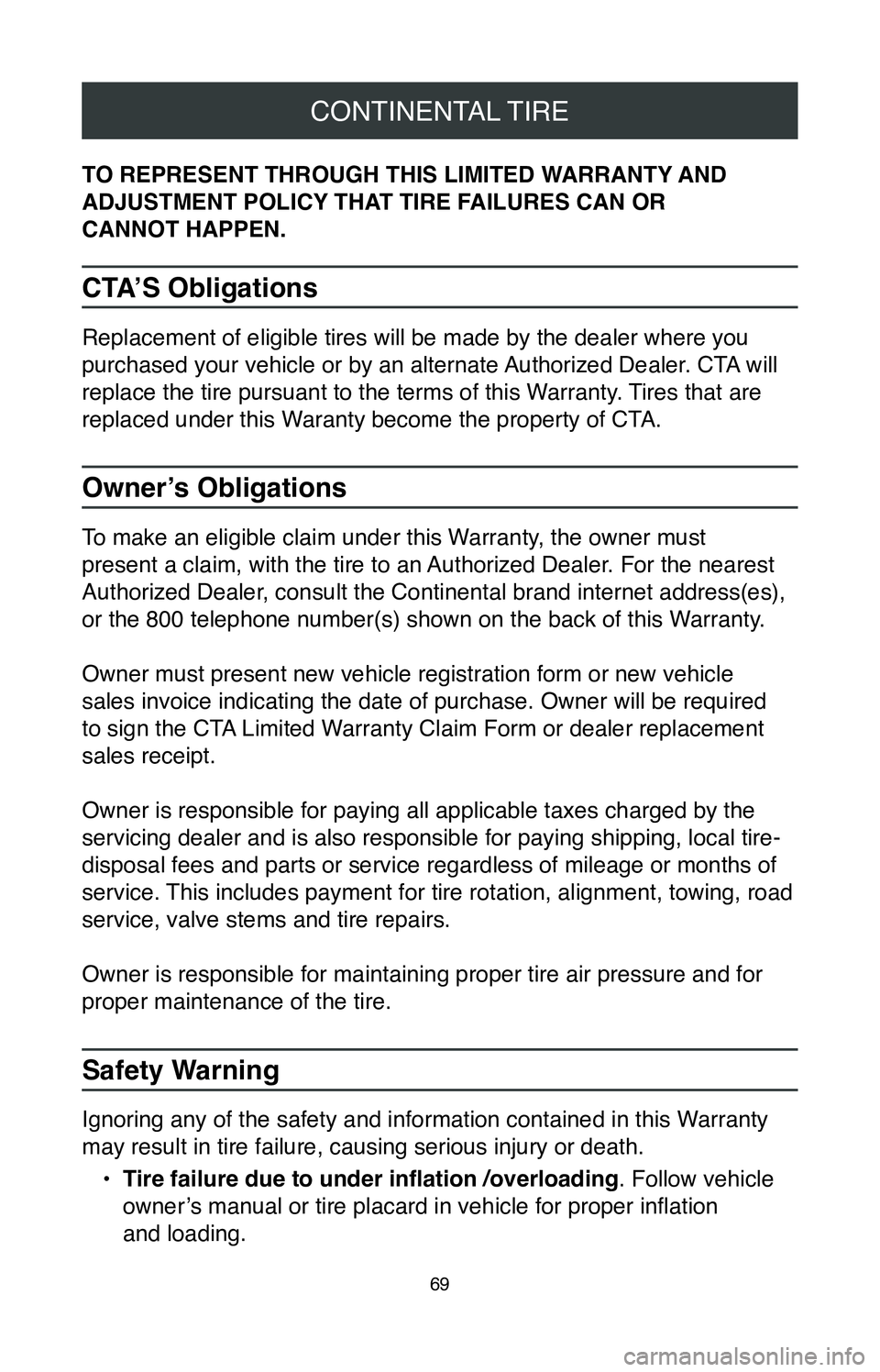
CONTINENTAL TIRE
69
TO REPRESENT THROUGH THIS LIMITED WARRANTY AND
ADJUSTMENT POLICY THAT TIRE FAILURES CAN OR
CANNOT HAPPEN.
CTA’S Obligations
Replacement of eligible tires will be made by the dealer where you
purchased your vehicle or by an alternate Authorized Dealer. CTA will
replace the tire pursuant to the terms of this Warranty. Tires that are
replaced under this Waranty become the property of CTA.
Owner’s Obligations
To make an eligible claim under this Warranty, the owner must
present a claim, with the tire to an Authorized Dealer. For the nearest
Authorized Dealer, consult the Continental brand internet address(es),
or the 800 telephone number(s) shown on the back of this Warranty.
Owner must present new vehicle registration form or new vehicle
sales invoice indicating the date of purchase. Owner will be required
to sign the CTA Limited Warranty Claim Form or dealer replacement
sales receipt.
Owner is responsible for paying all applicable taxes charged by the
servicing dealer and is also responsible for paying shipping, local tire-
disposal fees and parts or service regardless of mileage or months of
service. This includes payment for tire rotation, alignment, towing, road
service, valve stems and tire repairs.
Owner is responsible for maintaining proper tire air pressure and for
proper maintenance of the tire.
Safety Warning
Ignoring any of the safety and information contained in this Warranty
may result in tire failure, causing serious injury or death.•
Tire failure due to under inflation /overloading . Follow vehicle
owner’s manual or tire placard in vehicle for proper inflation
and loading.
Page 72 of 260
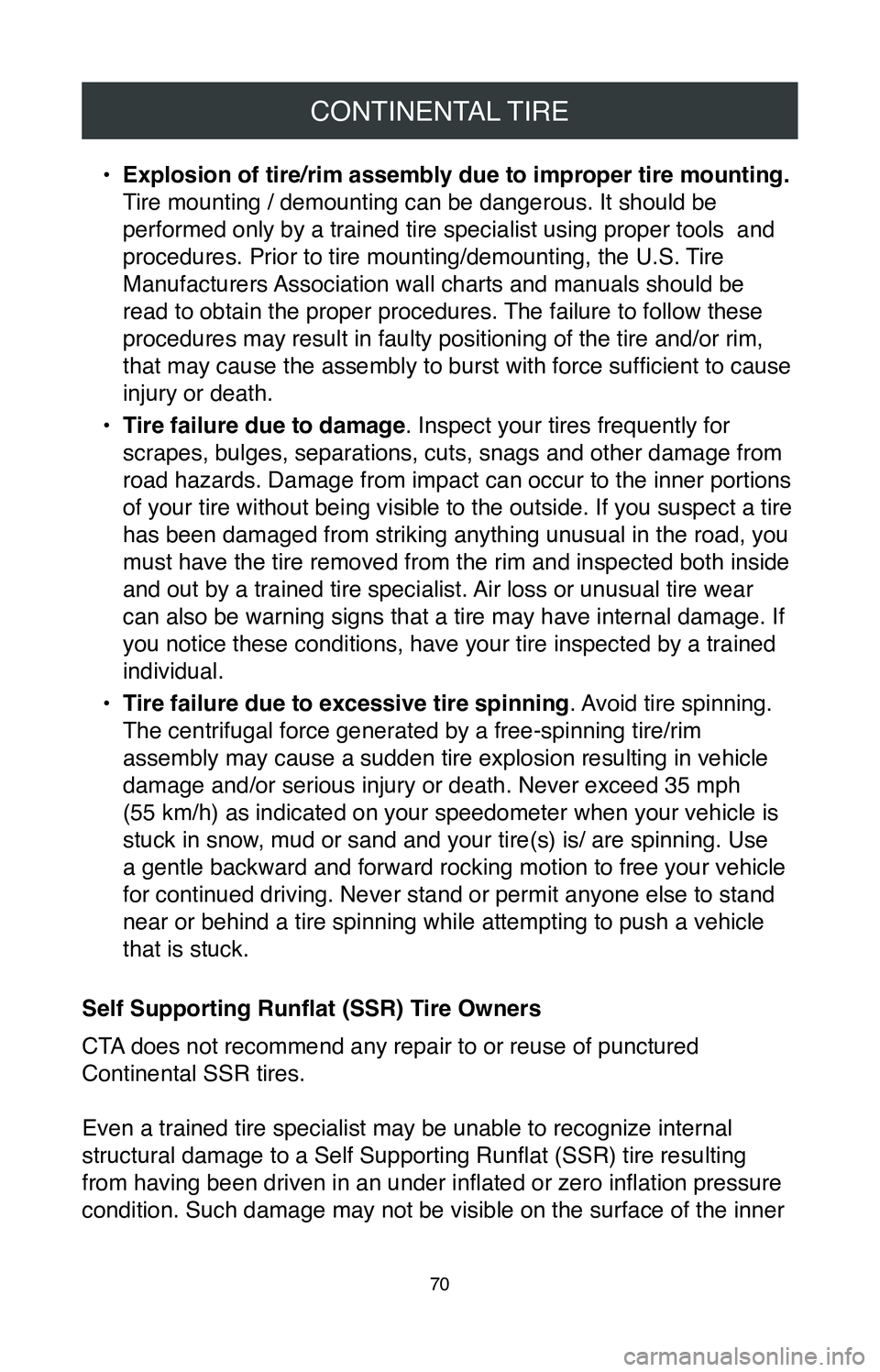
CONTINENTAL TIRE
70
• Explosion of tire/rim assembly due to improper tire mounting.
Tire mounting / demounting can be dangerous. It should be
performed only by a trained tire specialist using proper tools and
procedures. Prior to tire mounting/demounting, the U.S. Tire
Manufacturers Association wall charts and manuals should be
read to obtain the proper procedures. The failure to follow these
procedures may result in faulty positioning of the tire and/or rim,
that may cause the assembly to burst with force sufficient to cause
injury or death.
•
Tire failure due to damage. Inspect your tires frequently for
scrapes, bulges, separations, cuts, snags and other damage from
road hazards. Damage from impact can occur to the inner portions
of your tire without being visible to the outside. If you suspect a tire\
has been damaged from striking anything unusual in the road, you
must have the tire removed from the rim and inspected both inside
and out by a trained tire specialist. Air loss or unusual tire wear
can also be warning signs that a tire may have internal damage. If
you notice these conditions, have your tire inspected by a trained
individual.
•
Tire failure due to excessive tire spinning . Avoid tire spinning.
The centrifugal force generated by a free-spinning tire/rim
assembly may cause a sudden tire explosion resulting in vehicle
damage and/or serious injury or death. Never exceed 35 mph
(55 km/h) as indicated on your speedometer when your vehicle is
stuck in snow, mud or sand and your tire(s) is/ are spinning. Use
a gentle backward and forward rocking motion to free your vehicle
for continued driving. Never stand or permit anyone else to stand
near or behind a tire spinning while attempting to push a vehicle
that is stuck.
Self Supporting Runflat (SSR) Tire Owners
CTA does not recommend any repair to or reuse of punctured
Continental SSR tires.
Even a trained tire specialist may be unable to recognize internal
structural damage to a Self Supporting Runflat (SSR) tire resulting
from having been driven in an under inflated or zero inflation pressure
condition. Such damage may not be visible on the surface of the inner